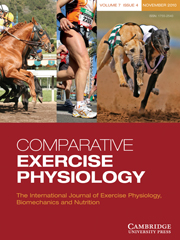Article contents
Effect of dietary supplements commonly used in Standardbred racing on plasma total carbon dioxide
Published online by Cambridge University Press: 15 April 2010
Abstract
Ten mature Standardbred mares (9–13 years, ~522 kg) were used to test the hypothesis that pelleted dietary supplementation would alter total plasma bicarbonate (tCO2) concentrations. All the mares used in this study were unconditioned, but were familiarized to the laboratory setting and running on a treadmill. Each of the ten mares was semi-randomly assigned one of four dietary treatments. The four treatments (oats as control and three pelleted feed supplements: Drive, Omolene and Strategy) were administered in a crossover fashion throughout a 4-week testing period. These products were chosen based on the frequency of their use by Standardbred/Thoroughbred owners and trainers in New Jersey. The horses underwent a simulated race test (SRT) on a treadmill (6% grade) at the end of each administration period. During the SRT, horses ran for 2 min at 4 m s− 1, 2 min at the speed previously shown to correspond to VO2max and 2 min at 4 m s− 1. Blood was collected before supplement treatment ( − 4 h), 10 min prior to exercise and at 0, 60 and 90 min post-exercise. Plasma concentrations of bicarbonate, sodium, potassium and chloride were measured using a Beckman ELISE analyser. The major finding of this study indicates that the plasma [tCO2], chloride and sodium concentrations were not altered by the dietary supplements studied (P>0.05). There were differences (P < 0.05) in plasma [tCO2] across sampling intervals ( − 4 h, − 10 min, +0 min, +60 min and +90 min) that were attributable to acute exercise (mean ± SE: 34.4 ± 0.9, 33.2 ± 1.1, 20.2 ± 0.8, 31.5 ± 0.8, 30.3 ± 1.6 mmol l− 1). There was a slight effect of treatment (P < − 0.05) on potassium levels. However, exercise was the main factor that caused substantial changes (P < 0.05) in the plasma tCO2, potassium, haematocrit and total protein concentrations. It was concluded that the pelleted diet supplements examined do not alter plasma [tCO2] in horses.
Information
- Type
- Research Paper
- Information
- Copyright
- Copyright © Cambridge University Press 2010
References
- 2
- Cited by

